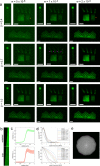Electron-beam patterned calibration structures for structured illumination microscopy
- PMID: 36418420
- PMCID: PMC9684522
- DOI: 10.1038/s41598-022-24502-0
Electron-beam patterned calibration structures for structured illumination microscopy
Abstract
Super-resolution fluorescence microscopy can be achieved by image reconstruction after spatially patterned illumination or sequential photo-switching and read-out. Reconstruction algorithms and microscope performance are typically tested using simulated image data, due to a lack of strategies to pattern complex fluorescent patterns with nanoscale dimension control. Here, we report direct electron-beam patterning of fluorescence nanopatterns as calibration standards for super-resolution fluorescence. Patterned regions are identified with both electron microscopy and fluorescence labelling of choice, allowing precise correlation of predefined pattern dimensions, a posteriori obtained electron images, and reconstructed super-resolution images.
© 2022. The Author(s).
Conflict of interest statement
The authors declare no competing interests.
Figures





References
Publication types
MeSH terms
Grants and funding
LinkOut - more resources
Full Text Sources

